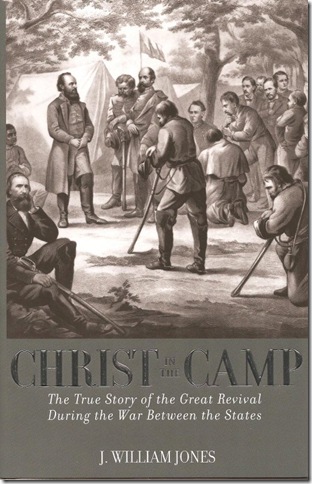 In a visit to Washington and Lee University, I had the pleasure of visiting the Robert E. Lee Chapel and Museum. In their bookstore, I happened upon the book Christ in the Camp: The True Story of the Great Revival During the War Between the States by J. William Jones (Sprinkle Publications). Jones was a chaplain in the Army of Northern Virginia, led by Confederate General Robert E. Lee. In this, Jones seeks to show the world (as the subtitle shows) the movement of revival in the Confederate armies through the arduous work of the Confederate army chaplains with their preaching and tract distribution.
In a visit to Washington and Lee University, I had the pleasure of visiting the Robert E. Lee Chapel and Museum. In their bookstore, I happened upon the book Christ in the Camp: The True Story of the Great Revival During the War Between the States by J. William Jones (Sprinkle Publications). Jones was a chaplain in the Army of Northern Virginia, led by Confederate General Robert E. Lee. In this, Jones seeks to show the world (as the subtitle shows) the movement of revival in the Confederate armies through the arduous work of the Confederate army chaplains with their preaching and tract distribution. In the process, Jones gives extended sketches on the Christian generals who led the Confederate army, such as Robert E. Lee, Thomas J. “Stonewall” Jackson, J.E.B. Stuart among others—men who provided great access and liberty and encouragement to these chaplains and their efforts. Included also are stories of great valor of Christian men such as Richard Kirkland who, as a recently converted Confederate soldier, raised the white flag to take water out to the wounded Union and Confederate soldiers who lay on the battlefield and provided each with a drink of water. The move brought a cease fire from both sides, and left Kirkland with the name “The Angel of Marye’s Heights” (you may read about him here).
Some reading this may wonder how such a revival could have taken place amongst the Confederate armies, since the Confederacy was a slave-based economy. Some may ask, “How could there be a move of the Spirit of God among a people who enslaved others based on their race?” A number of factors could be at play.
- The cultural standards of the day played too great a factor in how Christians viewed the world, and thus a revival was needed in order to open their eyes to this scourge. It should cause all of us to evaluate the institutions and mindsets we take for granted as part of our culture, but should never be a part of someone who names the name of Christ.
- Not everyone in the Confederacy was for the institution of slavery, just as not everyone in the Union was for the abolition of slavery. In the decades after the Civil War, we see that the predominate view of both North and South was that the black man was inferior to the white (see the campaign slogan of Gov. Horatio Seymour (D-NY) who ran against Ulysses S. Grant in 1868, who had the campaign slogan, “This is a White Man’s Country: Let the White Man Rule.”) This was the reigning view of many, who worried about the policies of Reconstruction and the violence that occurred in the South during this time. Lee and Jackson were against slavery (although Jackson did own five slaves whom he taught to read and write, something that was bordering on illegal in that time).
No comments:
Post a Comment